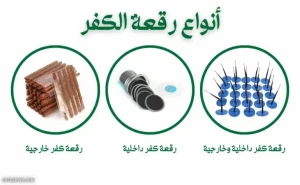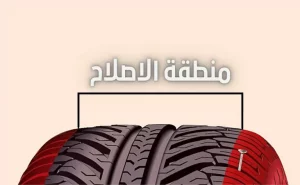The tire patch is an essential tool for any driver. Although some drivers do not have this patch in their car, it is considered one of the basic tools that everyone should have. It is an easy and effective means to save money, time, and effort required to replace tires with new ones.
We will discuss the different types of patches and when they should be used.

Types of Tire Patches
There are many different types of tire patches, and each type is used based on the type of tire and location of the puncture. Here are the different types:
Tire patching.
The circular patch is used to repair small holes in tires. This type of patch is characterized by its ease of use and does not require much experience in repair. It also comes in different sizes that match the size of the hole in the tire.
Inner tire patch
The square patch is used to repair holes in larger tires. This patch stands out as it contains rubber strips that are attached to the tire and cover the hole with rubber adhesive to achieve a permanent repair. It is preferred to use this type of patch on large tires due to its strength and durability.
Patching the leaking tire
Liquid patches are a new and innovative type, coming in a form of a liquid that is injected into the tire and is secured by the air inside it. This type of patch is known to effectively repair small holes and cracks, as well as improve the quality of the air inside the tire.
When should a tire patch be used?
A patch should be used in case of a puncture or tear in the tire as it can help repair and maintain it.Tire SafetyAnd limiting the likelihood of it bursting.
It is also important to use a patch in case there are any signs on the tire indicating damage, even if there is no puncture.
When the driver needs to use this patch, they must follow the necessary steps to ensure the success of the repair process. For example, the damaged area on the tire must be cleaned well before applying the patch, and it is important to ensure that the patch used matches the size of the hole.
Also read:Maintaining Car Tires: 6 Different Methods

Possible reasons for the appearance of a tire patch.
There are many reasons that lead to the appearance of this patch on.Car tiresAmong the most notable of these reasons are:
Repeated Friction
Repeated friction between the tires and the ground is a primary cause for the appearance of tire patches. This friction increases when driving the vehicle over long distances and on uneven road surfaces.
Incorrect Balance
The lack of proper balance between the front and rear wheels can lead to uneven tire wear and the appearance of patches on them.
Low air pressure
Low tire pressure is one of the main causes of tire patches appearing, as the low air pressure leads to greater wear on the tire sides.
Driving the car under harsh conditions.
Driving a car in harsh conditions, such as rugged or rocky roads or in the desert, can lead to tyre patches appearing as the tyres are exposed to strong vibrations and excessive wear.
To avoid car issues due to driving in harsh conditions, it is essential to install suitable tires for rough and desert roads and avoid driving at high speeds under such circumstances.
It is also recommended to regularly inspect the tires after driving under harsh conditions and perform the necessary maintenance for the tires to keep them in good condition.
Excessive Slippage
Over-sliding can occur when driving at excessive speeds on wet or slippery roads, leading to excessive friction between the tire and the road and the appearance of tire patches.
To avoid excessive skidding, one should avoid overspeeding and maintain good control of the vehicle when maneuvering on wet or slippery roads. It is also advisable to install suitable tires for weather conditions and rough roads to reduce the risk of excessive skidding and thus the appearance of tire patches.
Not cleaning the tires regularly
Neglecting to clean tires regularly can lead to the accumulation of dirt, impurities, and debris on the tires, which results in increased tire friction with the road and consequently leads to the appearance of tire patches.
Therefore, tires should be cleaned regularly using water, soap, and a soft brush. Care should be taken to remove all dirt and debris from the tires after cleaning.
Improper Usage
Incorrect use of tires can lead to tire patching problems, such as using inappropriate tires for weather conditions or rough roads.
This can also occur due to improper tire usage, such as excessive braking or speeding, which leads to increased friction between the tire and the road, ultimately resulting in the appearance of a tire patch.

The Conclusion
A tire patch is an essential tool for every driver seeking to maintain the safety of their car tires and avoid issues related to tire inflation. There are also numerous types of patches available, each of which is used depending on the type of tire and location of the puncture.
It is important to use a patch in case there are any signs on the tire indicating damage, so everyone should purchase a tire patch and store it in their car to maintain the safety of the tires and reduce the possibility of them bursting.

Comments